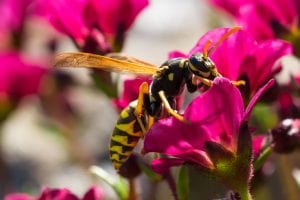
Maybe it buzzes, maybe it stings, and maybe it’s terrorizing your home and yard.
Wasps and bees are an important part of nature, but it can be very unsettling and unsafe to have them in your personal space.
This article will describe the differences between bees and wasps and provide tips about what you should do if you have a bee or wasp infestation in your yard.
As experts in identifying these species, as well as bee hive removal, we’ll also discuss the importance of removing the entire hive and other preventative tips for a bee-free home.
Wasp vs. Bee Identification
Bees and wasps may look and act alike from a distance, but there are actually many differences between them once you get to know them a bit better.
Wasps tend to be aggressive and can sting multiple times, while bees are less aggressive and honey bees actually die after stinging just once. Wasps are considered to be predators, while bees’ main role in nature is to pollinate plants. Visually, wasps appear long, thin, and have two pairs of legs. Wasps’ legs are smooth and round, while bees’ legs are hairy and flat. Bees are also fatter and more social with larger colonies. Wasps tend to eat flies, caterpillars, and other insects. However, bees are vegetarians and sip nectar from flowers.
Signs of a Wasp or Bee Infestation
Homeowners will quickly know if they have a wasp or bee problem if they see an increase in the number of insects flying around the yard. Aside from seeing an excessive number of bees, you may see nests in trees, under the eaves of your roof, in the attic, or in a garage or shed. It’s also a good idea to be able to identify a wasp nest or bee hive in case the insects remain contained inside.
Wasp Nest and Bee Nest Identification
Wasp nests are often made from chewed wood and have a papery appearance. These nests often start out small but grow over time, especially when protected in a wall cavity, garage, or roof space. Bumblebees, for example, typically build their nests in the ground or around decks and patios. You will likely hear bumblebees buzzing loudly to defend their nests if threatened. Methods of bee nest identification for carpenter bees include hearing bees chewing inside of wood, finding holes in unpainted wood, and finding piles of sawdust near wood.
Wasp and Bee Hive Removal
We are the New Jersey bee removal specialists, and we’re here to help you with all of your bee and wasp issues. Don’t delay calling us and risk getting stung!
Our highly trained team of bee removal professionals will remove all bees and their entire hives to prevent bees from coming back again without damaging beneficial insects or your property. Certain types of bees are endangered species, and environmental conservation is important to our business. We proudly serve the following areas with our bee removal services: Bergen County, Passaic County, Wayne, Teaneck, Mahwah, Paramus, Hackensack, Ramsey, Clifton, West Milford, Totowa, and Woodland Park.





